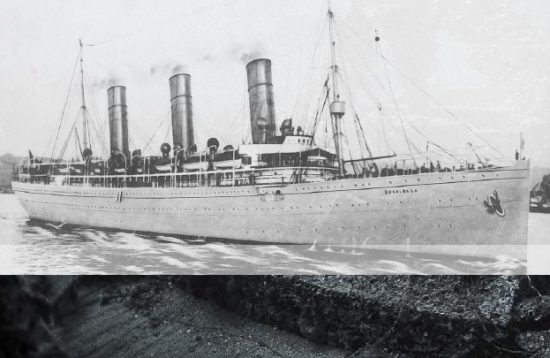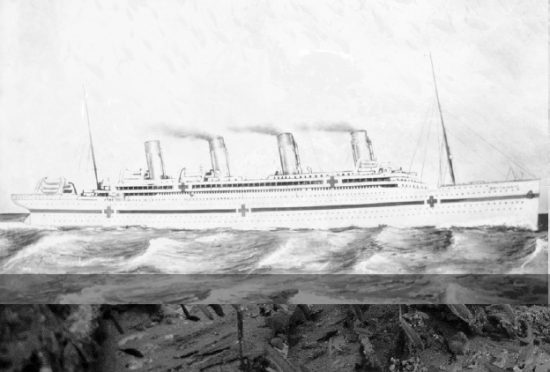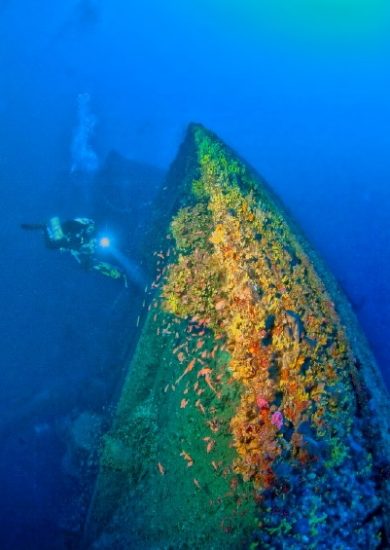







Memorial service and conference commemorates 100th Anniversary
The municipality of Kea and the Friends of Kea Society organised an
international conference from September 30th to October 2nd to
commemorate the 100th anniversary of the sinking of the S/S Burdigala
and the HMHS Britannic in the port of Kea.
Two of the most significant
shipwrecks of World War One, the ships were sunk after they hit mines
in November 1916. Taucher.Net was on site to report on the conference.
History of the wrecks
The S/S Burdigala (formerly named Kaiser Friedrich) was a high-speed
steamship owned by Norddeutscher Lloyd in the late 19th century.
With a
displacement of 12,481 BRT, it did not reach the required speed to ply
the North Atlantic route to New York, so it was chartered to HAPAG.
In
1912, it was sold to the French Compagnie de Navigation Sud-Atlantique
and renamed S/S Burdigala.
During World War One, the ship was acquired
by the French Navy and used as an armed troop transporter.
On 14
November 1916, it was in the Aegean Sea where it stuck a mine and sank.
The mine had been laid by German submarine U73, in the area known as
minefield No. 32.
Seven days later, on the morning of November 21st, the HMHS Britannic
was sunk by mines also laid by U73.
Requisitioned during World War I by
the British Admiralty, the HMHS Britannic was an passenger liner that
had been converted into a hospital ship. On that fateful day, it was
travelling northward towards the port of Mudros to pick up up to 2,500
wounded British soldiers. It never reached its destination.
More than 1,000 people, comprising crew, doctors and nurses, were on
board the HMHS Britannic when it sank. The tragedy left 30 dead and 40
wounded — most of them had been in two lifeboats that had departed the
ship without permission and were crushed by the still-rotating
propellers.
With a displacement of 48,158 GRT, the HMHS Britannic had been the
world’s largest ocean liner at the time. Constructed at the Harland and
Wolff shipyard, it was the sister ship of the Olympic and Titanic, and
had its keel laid on 30 November 1911, more than two and a half years
after the Titanic's own keel was laid. The HMHS Britannic was not
identical to the two ships, as its hull was 46cm wider.
The memorial event
Friday, 30 September 2016
At the wrecks of the S/S Burdigala and HMHS Britannic, commemorative
plaques were placed by technical divers. A flotilla of ships departed
from Agios Nikolaos Bay and sailed to the site of the shipwrecks in the
Port of Kea, where a memorial service was held and wreaths laid in the
sea. Ambassadors and the naval attachés of France, Britain and Germany
took part in the memorial service.
Saturday and Sunday, 01-02 October 2016
Over the weekend, a number of conferences about the S/S Burdigala and
HMHS Britannic were held. Prominent speakers from the wreck diving
scene, including famous wreck divers Richie Kohler and Derk Remmers,
were present to speak on the two wrecks. The topics included the
historical and ecological facts about the wrecks, and the various
discoveries made by research and dive expeditions concerning the two
ships.
Further information:
https://100years-kea-shipwrecks.org/
https://www.youtube.com/channel/UCddsawR9TfcSu0PTrzU_Pyg
http://www.ekathimerini.com/207516/article/ekathimerini/news/kea-island-eyes-future-as-mecca-for-divers
 Herbert
Herbert 1st October 2016
1st October 2016 Kea, Greece
Kea, Greece